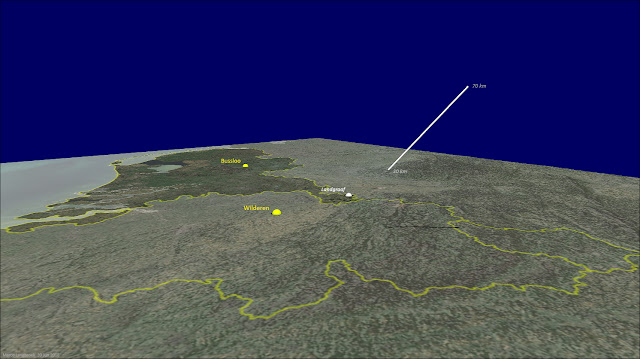In early evening twilight of 16 June 2018, around 21:11 UT (23:11 local time), a brilliant fireball at least as bright as the full moon and fragmenting into multiple pieces, appeared over NW Europe. It was widely seen and reported by the public in the Netherlands, Belgium, France and Germany. It garnered a lot of press attention, especially in the Netherlands.
The fireball notably rose to fame because it appeared over the stage of a concert by the Foo Fighters at Pinkpop, the large annual music festival at Landgraaf in the Netherlands. Here is footage of the event over the stage:
From this video, we can determine that the fireball duration was at least 1.65 seconds, and probably longer as the video clearly did not record the start of the fireball but only part of the apparition.
At first it seemed there were no records of the fireball by our dedicated meteor camera network, as it was still very early in twilight. But as it turned out the All-Sky meteor camera of Jean-Marie Biets in Wilderen in Belgium, where it is slightly darker than more north like in the Netherlands at this time of the year, had captured it in a still bright blue sky with only a few stars (and bright planet Jupiter) visible. Here is the image:
 |
| The fireball as seen from Wilderen, Belgium. Image (c) Jean-Marie Biets. click image to enlarge |
Another image, that popped up through Twitter, was made by a German amateur astronomer, Uwe Reichert from Schwetzingen, who was photographing the conjunction between the moon and Venus low in the west when the fireball shot through the field of view of his camera. That yielded this very nice picture, which also clearly shows the fragmentation into at least two fragments:
 |
| image (c) Uwe Reichert |
 |
| Detail of previous image showing fragmentation. Image (c) Uwe Reichert. |
(Note: while it appears as if the fireball pierces a cloud, it in reality appeared behind the cloud, being bright enough to shine through the thinner edges of the cloud. It ended well above cloud levels.)
The Landgraaf video shows at least 5 separate fragments near the end of the fireball apparition:
 |
| Fragmentation into 5 pieces on the Landgraaf video. Click to enlarge. |
Based on the Wilderen and Schwetzingen images and some quick azimuth determinations for the fireball endpoint using Jupiter, Venus, the moon and the few bright stars visible on the Wilderen image as reference, I made this cross-bearing as a quick initial assessment, suggesting the fireball appeared over the Belgian Ardennes in the southeast Belgian province of Wallonia, close to the border with Luxemburg:
 |
| click to enlarge |
Next, it turned out that there was a second meteor camera image, from the All Sky camera located at Bussloo Public Observatory (Mark-Jaap ten Hove):
 |
The fireball as seen from Bussloo, the Netherlands. Image (c) Mark-Jaap ten Hove/Bussloo Public Observatory. click image to enlarge |
Like the Wilderen image, only a few stars are visible, not enough to do serious astrometry. I therefore used a trick to get decent astrometry on the images: I asked both photographers for images from somewhat later that night. By measuring star positions on those, I could create an astrometric grid over the camera field, yielding the positions of the start and end of the fireball on both images. This means that, with triangulation, a proper atmospheric trajectory could be reconstructed.
The result is this trajectory, with the endpoint of the fireball only a few km from where my initial crude cross-bearing analysis had placed it:
 |
| click to enlarge |
The fireball started over the Luxemburg-Belgian border, at 70 km altitude. It came in from the southeast under a steep angle (48 degrees with the horizontal), and ended over the Belgian Ardennes at 30 km altitude. The endpoint is located some 30 km south of Liege.
The apparent radiant of the fireball is on the Ophiuchus-Hercules border. As alas no speed information is available (the Wilderen image has no discernable sektor breaks; the Bussloo camera is unsectored), a precise geocentric radiant cannot be given, and a precise heliocentric orbit cannot be computed either.
The Landgraaf video however puts some constraints on the maximum speed: that cannot have been above 29 km/s, and was probably much less as the Landgraaf video did not pick up the fireball from the start. This is an interesting constraint. For a range of likely speeds up to 24 km/s, the resulting orbits are all asteroidal in character with inclinations smaller than 23 degrees and aphelion within the orbit of Jupiter.
The map below shows the observed apparent radiant (blue) and geocentric radiant positions for a range of assumed speeds (red):
 |
| click map to enlarge |
The fireball penetrated deeply into the atmosphere and showed fragmentation, but the lack of speed data precludes a definite statement on the end velocity and on whether something could have survived. An end altitude of 30 km is a borderline case: most meteorite droppers end lower, at 25-15 km altitude.
Acknowledgement: I thank Mark-Jaap ten Hove and Jean-Marie Biets for making available their all-sky images for analysis.
Note: the radiant map initially had a labelling error in the declination. This has been corrected

No comments:
Post a Comment